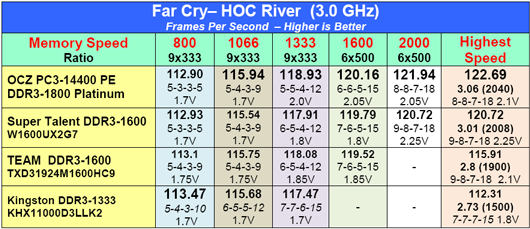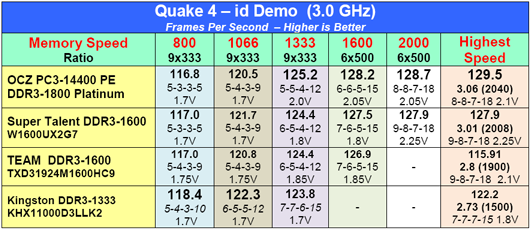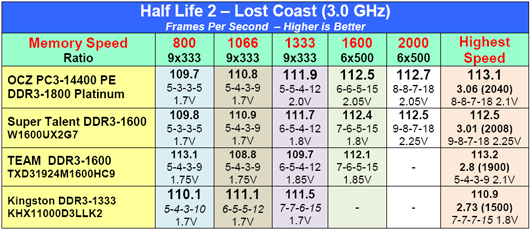Gaming
Three DX9 games representing different gaming engines were used to test the performance of the OCZ DDR3-1800 Platinum in real world gaming. There are more recent gaming titles available, but they are also DX9. We will update games in the memory test suite as soon as a selection of DX10 games with reliable benchmarks is available. At that time the memory test OS will also be moved to Vista.
The Far Cry - River demo was run for three loops and results in FPS were averaged over the three runs. ALL games were run at 1280x1024 resolution, which is the maximum resolution for the most common 19" flat panel monitors.
The Kingston tops performance at the slower DDR3-800 speed, but the Micron Z9-based memory takes top honors from 1066 to the Highest Speed DDR3. OCZ manages the best performance at those speeds with slightly faster timings than other Z9-based memory.
Quake 4 and the underlying engine have always proved to be very sensitive to improvements in memory bandwidth. This is amply demonstrated in these memory tests. Kingston, based on Elpida LL memory, performs best at the slower 800 and 1066 speeds, with OCZ and the other Z9 memory topping DDR-1333 to DDR3-2000. The pattern is basically the same as in Far Cry. With the constant CPU speed of 3.0GHz we see frame rates improve from 116.8 at DDR3-800 5-3-3 to 128.7 at DDR3-2000 9-8-7, an improvement of just over 10%. We have commented many times that memory is just one small part of the performance equation, but a 10% improvement in a game frame rate merely as the result of an increase in memory speed (and FSB speed, though we can't isolate that factor at present) is significant. Far Cry sees a similar increase from 112.90 at 800 to 121.94 at DDR3-2000, which is about an 8% improvement.
We include Half-Life 2: Lost Coast as a representative of games that are less sensitive to improvements in memory bandwidth. Lost Coast is played through the Steam engine, where there is the constant worry, for a reviewer, that each new update of Steam will break your test benchmarks. Though the differences are very subtle and HL2 performance is most influenced by the video card and CPU used in the benchmark, there are nonetheless patterns that are the same as the other two games. The Kingston wins by a small margin at 800 and 1066, while the OCZ tops the performance of Lost Coast from 1333 to 2000+. This game is not very sensitive to memory bandwidth so it is no real surprise that the performance improvement form 800 to 2000 is a small 3%.
Three DX9 games representing different gaming engines were used to test the performance of the OCZ DDR3-1800 Platinum in real world gaming. There are more recent gaming titles available, but they are also DX9. We will update games in the memory test suite as soon as a selection of DX10 games with reliable benchmarks is available. At that time the memory test OS will also be moved to Vista.
The Far Cry - River demo was run for three loops and results in FPS were averaged over the three runs. ALL games were run at 1280x1024 resolution, which is the maximum resolution for the most common 19" flat panel monitors.
 |
| Click to enlarge |
The Kingston tops performance at the slower DDR3-800 speed, but the Micron Z9-based memory takes top honors from 1066 to the Highest Speed DDR3. OCZ manages the best performance at those speeds with slightly faster timings than other Z9-based memory.
 |
| Click to enlarge |
Quake 4 and the underlying engine have always proved to be very sensitive to improvements in memory bandwidth. This is amply demonstrated in these memory tests. Kingston, based on Elpida LL memory, performs best at the slower 800 and 1066 speeds, with OCZ and the other Z9 memory topping DDR-1333 to DDR3-2000. The pattern is basically the same as in Far Cry. With the constant CPU speed of 3.0GHz we see frame rates improve from 116.8 at DDR3-800 5-3-3 to 128.7 at DDR3-2000 9-8-7, an improvement of just over 10%. We have commented many times that memory is just one small part of the performance equation, but a 10% improvement in a game frame rate merely as the result of an increase in memory speed (and FSB speed, though we can't isolate that factor at present) is significant. Far Cry sees a similar increase from 112.90 at 800 to 121.94 at DDR3-2000, which is about an 8% improvement.
 |
| Click to enlarge |
We include Half-Life 2: Lost Coast as a representative of games that are less sensitive to improvements in memory bandwidth. Lost Coast is played through the Steam engine, where there is the constant worry, for a reviewer, that each new update of Steam will break your test benchmarks. Though the differences are very subtle and HL2 performance is most influenced by the video card and CPU used in the benchmark, there are nonetheless patterns that are the same as the other two games. The Kingston wins by a small margin at 800 and 1066, while the OCZ tops the performance of Lost Coast from 1333 to 2000+. This game is not very sensitive to memory bandwidth so it is no real surprise that the performance improvement form 800 to 2000 is a small 3%.










25 Comments
View All Comments
MadBoris - Tuesday, July 31, 2007 - link
"Far Cry sees a similar increase from 112.90 at 800 to 121.94 at DDR2-2000"I think you meant DDR3-2000. Although DDR2-2000, would be nice. ;)
Wesley Fink - Tuesday, July 31, 2007 - link
Corrected.Spoelie - Tuesday, July 31, 2007 - link
...populating only one channel? With dual channel bandwidth exceeding double the bandwidth of the fsb, I'm curious as to how a single channel with equal or more bandwidth than the fsb would perform.Myrandex - Tuesday, July 31, 2007 - link
Eh I hate it when people run dual channel boards in a single channel config. I remember a laptop review of the new Turion X2 and they were running it in single channel mode with onboard video. Heck where I work they do that all the time in the ATM systems that they manufacture. They pay for the dual channel chipset, yet they configure it to run in single channel mode.YellowWing - Tuesday, July 31, 2007 - link
Thanks for keeping the CPU clock constant this time. We get the chance to see what the memory is adding without having to factor out the CPU clock changes. I look forward to new straps for a completely even test environment.Wesley Fink - Tuesday, July 31, 2007 - link
You're welcome. All of your suggestions on making this a better memory test platform were very helpful. We need 1600 and 2000 memory straps right now with DDR3 boards. I sincerely doubt that it even occurred to JEDEC and motherboard makers that we would be caring about DDR3-2000 this early in the development of DDR3. The memory speed development of DDR2 seems almost glacial by comparison.mostlyprudent - Tuesday, July 31, 2007 - link
Although I did not participate in the discussion of the last article, I did follow it and want to tip my hat to Wes (and really all the AT authors) for being willing to engage readers in the comments and apply the feedback and critiques offered. This is why, IMHO, AT has continued to get better and better over the years.qpwoei - Tuesday, July 31, 2007 - link
As a critic of the last article, I'd like to chime in and say well done on this one as well. Unfortunately, I don't think you'll be seeing any > 1:1 ratios on external chipsets (ie: non-IMC) for a while, if ever. The design issues for making > 1:1 ratios really outweigh the benefits, especially in a system where the memory bandwidth is already twice the FSB bandwidth.MadBoris - Tuesday, July 31, 2007 - link
Hey wesley,I also wanted to say thanks for the more apples to apples comparison with DDR2. I think this is really of utmost importance to most folks before we start comparing DDR3 among other DDR3 modules. As exciting as DDR3 is as a technology we still want to see the real world performance improvement over DDR2 to justify for ourselves any price increase with new purchases, let alone the three fold price increase. If I get 3 to 4 percent less performance for 1/3 the price then that is a good purchasing decision for me. All new memory suffers from these teething pains, I just wanted them quantifiable.
In further search for the real world comparison and the true advantages that DDR3 brings at it's current highest speeds comared to DDR2 at it's highest speeds(1066 in this case), I did have to flip back and forth between pages 4 and 7 several times. With page 4 using a 2.66 GHZ CPU clock frequency and page 7 using 3GHZ, a direct comparison in the benchmark numbers themselves wasn't possible due to the 10% CPU difference. Initially page 7 scores looked much better than page 4 until I factored in the 10% CPU difference. It took a few minutes to come to a method of distinguishing the real world advantage of DDR3 running at it's highest speeds, compared to DDR2 at it's higher speeds.
basically, I came to the conclusion if 1333 is where DDR3 starts to get it's legs and surpass DDR2(as you state on page 4). Page 4 doesn't actually show the 1333 speeds of DDR2 in the chart (as none exists), but you can see there is a minor advantage in the two games emerging over the previous chart with 1066 DDR2. So then comparing DDR3 at 1333 to DDR3 at highest speeds on page 7 gives me a rough estimate of the "real world" performance of DDR3 at it's highest speed over what DDR2 has it's highest speeds (with an additional 1% tossed in as advantage over 1066 ddr2). All this extrapolation was necessary due to the 10% CPU difference. Not complaing, just stating a fact in trying to get to the real world benefits if I was going to by a platform today, and having to justify the cost/performance ratio.
In the end, the real world benefit of DDR3 at it's highest speeds, compared to a P35 running DDR2 at it's highest speeds(both with fastest timings using 1333 as the cutoff where DDR2 is left behind) came out to about 3 - 5 percent real world gaming benefit in benchmarks of Far Cry and Quake 4. Obviously the synthetics showed much more, but they always do. All that of course is based on the reality that 1333 is where the performance shift takes place with the current fastest DDR2 and fastest DDR3, which is what I was after. To me, 3 - 5 percent definitely doesn't justify 3 times the cost of the memory yet, especially if a board supports both DDR2 and DDR3.
Anyway, thanks for making an apples to apples comparison more possible in this review, even though not exact, I could extrapolate the necessary info I wanted. I'm sure as latency continues to lower on DDR3, than all this additional frequency will be worth something beyond the current meager benefits over DDR2 at 1066.
indeed - Tuesday, July 31, 2007 - link
Is there any chance that we'll be seeing DDR2 1066 4GB packs with 2 modules any time soon?